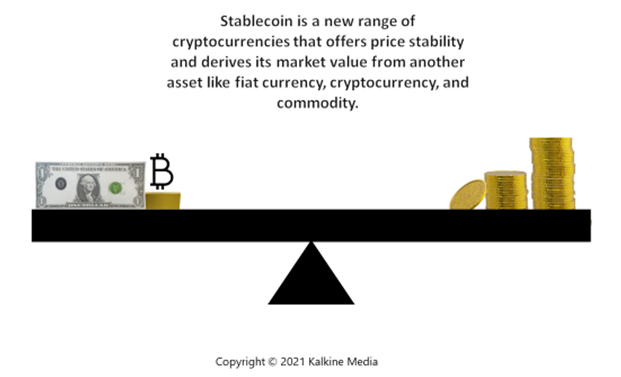Definition
Related Definitions
Stablecoin
What is a stablecoin?
A stablecoin is a new range of cryptocurrencies that offers price stability and derives its market value from an external reference. Unlike fiat money, they are backed by reserve assets like commodities, currencies, and other financial capital.
The first of its kind, Tether, was launched in 2015.
Stablecoins have gained popularity over the years as they aim to bring people both the safety and stability, something that is generally believed to lack in cryptos. Stablecoins appear to maintain prices and avoid excess volatility due to being backed by assets.
Most popular stablecoins trace the value of fiat currencies like Euros (EUR) and US Dollars (USD or US$). By having a cryptocurrency that behaves like EUR or USD, or any other relatively safer asset, the market participants are relaxed when the market is volatile.
The stablecoins have increased over time as there is an increased demand for improved speed, liquidity, and transparency. Some of them are:
- Tether (USDT)
Tether is a popular stablecoin in the cryptocurrency market as it possesses the highest trade volume and market capitalization compared to any other stablecoin. It is backed by USD and maintains a 1:1 ratio with it. Tether Limited has no guarantee for the exchange and redemption of USDT for real money. Hence, Tether cannot be exchanged for US$.
- USD Coin (USDC)
USD Coin has become famous as the cryptocurrency market is growing and is fully backed by US$. USDC is built on the famous Ethereum protocol- ERC20. It is managed by the most well-trusted crypto companies in the world, Circle and Coinbase. All the worldwide transactions occur via established finance firms and comply with the U.S. money transmission laws.
- TrueUSD (TUSD)
TrueUSD is a well-trusted stablecoin backed by US$ that is greatly benefited from the cryptocurrency’s market growth. TrueUSD are built on the TrustToken platform that tokenizes all types of assets like commodities, real estate, trademarks, patents, businesses, etc., encouraging everyone to participate in fractional ownership.
- Paxos Standard Token (PAX)
This token is a USD-collateralized stablecoin that is fully managed by Paxos Trust Company and controlled by the New York State Department of Financial Services. The Paxos Standard Tokens are built on ERC-20 protocol and are collateralized in a 1:1 ratio with USD.

What was the need to introduce stablecoins?
A cryptocurrency is a digital currency, which operates on blockchain technology using decentralized networks. Users have praised the processing system of cryptocurrency that is smooth, instant, and private.
Cryptocurrency is highly volatile and considered a non-conventional asset because its trading is illegal in many countries. As a result, the intraday price swings in cryptocurrencies are very high. The uncertainty due to price movements and short-term volatility makes cryptocurrencies unsuitable for daily trading by non-experts.
Cryptocurrencies must have a store of value and should be stable for a more extended period. Fiat currency’s value is guaranteed by the government and issued by the respective country's central bank. On the contrary, cryptocurrencies are not issued by governments. Hence, they must seek other methods for price stabilization.
As of June 2021, neither the governments manage cryptocurrencies, nor the financial intermediaries neutralize the mismatch between supply and demand. Stablecoins enables users to bridge the gap between the stability of fiat currency and cryptocurrencies.

Frequently Asked Questions (FAQs)
- What different types of stablecoins are there?
The stablecoins are categorized based on their working mechanism:
- Fiat-collateralized stablecoin:
The fiat-collateralized stablecoin is backed by sovereign currency like Pounds, USD, etc. So, for instance, to issue a specific number of tokens of a given cryptocurrency, the issuer will offer the dollar reserves worth the same amount as the collateral. The custodian functions individually to maintain the reserves and are reviewed for compliance on a regular basis. Tether and TrueUSD are the cryptocurrencies backed by USD.
- Commodity-collateralized stablecoin:
The commodity-collateralized stablecoin is backed by interchangeable assets like precious metals. Gold is the most common commodity used as collateral, and there are other stablecoins backed by real estate, oil and other precious metals.
- Crypto-collateralized stablecoin:
The crypto-collateralized stablecoin is backed by other cryptocurrencies. Therefore, such stablecoins might not be conventionally safe and are highly volatile. These currencies are also known as over-collateralized, as they require relatively larger cryptocurrencies reserve to issue a small number of tokens.
- Algorithmic/ Non-collateralized stablecoin:
The non-collateralized stablecoin is not backed by any of the asset reserves, and its stability is derived from its working mechanism. For instance, the base coin cryptocurrency deploys a consensus mechanism to determine the supply of tokens.
- What are the limitations of stablecoin?
The stablecoin also have some limitations along with the advantages:
- Trust problem: The fiat-collateralized stablecoin are centralized, operated by a sole unit. It requires to build the trust that the entity is backing up the stablecoins with fiat currency. The stablecoin must provide third-party audits to build trust and to ensure transparency. For instance, Tether is an example of how a stablecoin go wrong.
- Regulations: The stablecoins backed by the fiat currency are constrained by the regulations. They can compromise the effectiveness of the exchange process and the digital asset’s possible efficiency.
- Risk: In the case of stablecoins, there is always a risk of crashing the underlying asset's value. For instance, crypto-backed stablecoin are more vulnerable to price instability than fiat and commodity-backed coins.
